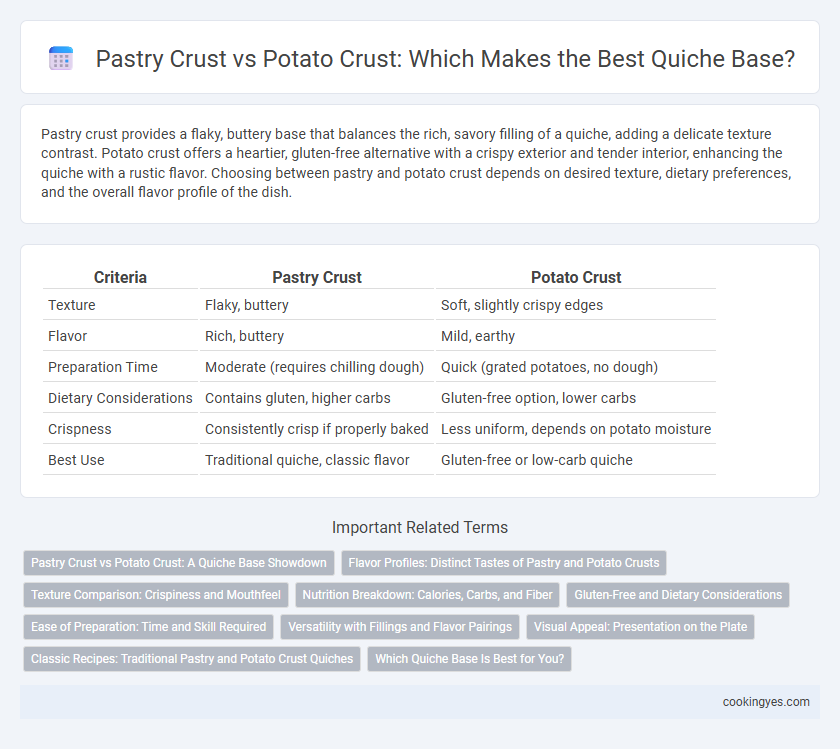Pastry crust provides a flaky, buttery base that balances the rich, savory filling of a quiche, adding a delicate texture contrast. Potato crust offers a heartier, gluten-free alternative with a crispy exterior and tender interior, enhancing the quiche with a rustic flavor. Choosing between pastry and potato crust depends on desired texture, dietary preferences, and the overall flavor profile of the dish.
Table of Comparison
| Criteria | Pastry Crust | Potato Crust |
|---|---|---|
| Texture | Flaky, buttery | Soft, slightly crispy edges |
| Flavor | Rich, buttery | Mild, earthy |
| Preparation Time | Moderate (requires chilling dough) | Quick (grated potatoes, no dough) |
| Dietary Considerations | Contains gluten, higher carbs | Gluten-free option, lower carbs |
| Crispness | Consistently crisp if properly baked | Less uniform, depends on potato moisture |
| Best Use | Traditional quiche, classic flavor | Gluten-free or low-carb quiche |
Pastry Crust vs Potato Crust: A Quiche Base Showdown
Pastry crust offers a flaky, buttery foundation that crisps perfectly while enhancing the classic quiche texture, contrasting with the denser, earthier potato crust which provides a hearty, gluten-free alternative rich in flavor. The pastry crust's delicate structure supports creamy custards and varied fillings without overshadowing their taste, whereas potato crust introduces a rustic, savory dimension ideal for rustic or vegetable-heavy quiches. Selecting between pastry and potato crust ultimately depends on the desired texture, flavor profile, and dietary preferences, making each a distinctive choice in quiche preparation.
Flavor Profiles: Distinct Tastes of Pastry and Potato Crusts
Pastry crust for quiche offers a rich, buttery flavor with a flaky texture that enhances the savory fillings by adding a delicate crispness. Potato crust delivers a hearty, earthy taste with a denser, slightly creamy texture, creating a rustic contrast to traditional quiche ingredients. The choice between pastry and potato crusts significantly influences the overall flavor profile, balancing richness with earthiness depending on the desired taste experience.
Texture Comparison: Crispiness and Mouthfeel
Pastry crust offers a flaky, buttery texture that crisps evenly, creating a light yet sturdy base for quiche, enhancing each bite with a tender mouthfeel. Potato crust provides a denser, slightly chewy texture with a subtle crispiness on the edges, contributing to a more rustic and hearty eating experience. The choice between pastry and potato crust significantly influences the overall sensory profile, balancing crispiness with richness in different ways.
Nutrition Breakdown: Calories, Carbs, and Fiber
Pastry crust quiche bases typically contain higher calories and carbohydrates due to refined flour and added fats, averaging around 200-250 calories and 20-25g carbs per serving, with minimal fiber content under 2g. Potato crust quiche bases offer a lower calorie alternative, approximately 150-180 calories per serving, with slightly fewer carbohydrates (15-20g) and increased dietary fiber of 3-4g, contributing to better digestion and satiety. The nutritional advantage of a potato crust lies in its balance of lower carbs and enhanced fiber, making it a beneficial option for those seeking lighter, fiber-rich quiche bases.
Gluten-Free and Dietary Considerations
A pastry crust for quiche offers a traditional, flaky texture but contains gluten, making it unsuitable for those with celiac disease or gluten sensitivity. A potato crust serves as a gluten-free alternative, providing a sturdy and naturally gluten-free base while adding extra nutrients like potassium and fiber. Choosing between these crusts depends on dietary restrictions and desired texture, with potato crust being ideal for gluten-free and lower-carb diets.
Ease of Preparation: Time and Skill Required
Pastry crust for quiche requires precise handling and longer preparation time, including chilling and rolling dough, demanding intermediate baking skills for a crisp and flaky texture. Potato crust offers a quicker, less technical alternative, where shredded or sliced potatoes are pressed and pre-cooked, making it accessible for beginners with minimal prep time and reducing the risk of sogginess. Choosing between the two depends on desired texture and available time; pastry crust delivers traditional flakiness, while potato crust simplifies the process without sacrificing flavor.
Versatility with Fillings and Flavor Pairings
Pastry crust offers a flaky, buttery texture that complements a wide range of classic quiche fillings like spinach, mushrooms, and Swiss cheese, enhancing rich and savory flavor profiles. Potato crust provides a sturdy, slightly earthy base that pairs exceptionally well with heartier ingredients such as bacon, caramelized onions, and sharp cheddar, adding a rustic dimension to the dish. Both crusts offer distinct versatility, allowing cooks to tailor flavor pairings and textures to suit traditional or inventive quiche recipes.
Visual Appeal: Presentation on the Plate
Pastry crust offers a golden-brown, flaky appearance that enhances the quiche's classic elegance and crisp edges, creating an inviting visual contrast with creamy fillings. Potato crust presents a rustic, textured look with a slightly rough surface and a warm, earthy color that adds a hearty, homestyle charm to the dish. Choosing between these crusts depends on whether the desired presentation leans toward refined sophistication or cozy, approachable appeal.
Classic Recipes: Traditional Pastry and Potato Crust Quiches
Classic quiche recipes traditionally feature a buttery pastry crust that provides a flaky, tender base, enhancing the rich, creamy filling of eggs, cream, and cheese. Potato crust quiches offer a rustic alternative, using grated or thinly sliced potatoes to create a crispy, golden foundation that adds a hearty texture and subtle earthy flavor. Both crusts influence the quiche's overall taste and texture, with pastry crusts emphasizing lightness and flakiness, while potato crusts contribute a denser, more savory experience.
Which Quiche Base Is Best for You?
A pastry crust offers a flaky, buttery texture that complements savory quiche fillings, ideal for those seeking a classic, rich flavor. A potato crust provides a gluten-free alternative with a denser, heartier bite, perfect for adding extra substance and nutrients to the dish. Choosing between pastry and potato crust depends on dietary preferences and desired texture, with pastry suited for traditional tastes and potato crust favored for a unique twist and added nutrition.
Pastry crust vs Potato crust for quiche base Infographic

 cookingyes.com
cookingyes.com